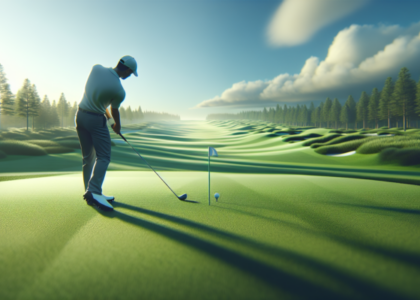Mastering the Concept of Spin in Golf
What is Spin in Golf and Why Does It Matter?

How to Hit a Golf Ball with Spin: Spin in golf is a critical factor that relates to the rotation of the ball after it is struck, profoundly impacting its trajectory and behavior upon landing on the green. This fundamental concept is crucial for golfers seeking to enhance their performance on the course. For example, gaining insight into how spin affects ball flight empowers golfers to execute more precise shots, especially when approaching the green. Whether a player seeks to halt the ball quickly on the putting surface or to create a controlled draw or fade, mastering the art of spin is a vital skill.
When a golfer makes contact with the ball, several factors come into play, including the angle of the clubface, the speed of the swing, and the specific point of impact. These elements collectively determine the amount of spin imparted on the ball. This spin not only regulates the height at which the ball ascends but also influences its stopping power upon landing. In South African golf courses, known for their diverse terrains and greens, a robust understanding of spin mechanics can set apart an average golfer from an exceptional one, allowing for effective adaptation to various playing conditions.
Exploring the Different Types of Spin in Golf
Golfers encounter three primary types of spin: backspin, topspin, and sidespin. Each type plays a unique role in how the ball behaves in the air. Backspin is crucial for achieving a gentle landing on greens, particularly on the undulating courses found in regions like the Western Cape. Conversely, topspin is often used for longer shots to enhance roll after the ball lands, which is particularly beneficial on firm fairways.
Sidespin is responsible for curving the ball left or right during its flight, making it essential for golfers aiming to navigate obstacles effectively. Understanding these different types of spin is crucial for golfers who wish to exercise greater control over their shots. For instance, mastering backspin can lead to more accurate approaches, while managing sidespin can be invaluable for avoiding hazards like trees or bunkers. In South Africa, where courses frequently feature varying slopes and changing wind conditions, employing the appropriate type of spin can significantly bolster a golfer's performance.
Listen With Me?
Why Spin Control is Essential for Every Golfer
Managing spin is of utmost importance in golf as it can dramatically influence a player's ability to shape their shots and control distance. A well-executed backspin, for example, can help the ball stop quickly on the green, minimizing the risk of rolling past the hole. On the other hand, unwanted spin can result in mishits, such as hooks or slices, which can derail an otherwise promising round. In the diverse conditions found on South African golf courses, mastering spin control allows players to adjust their shots as needed, enhancing their overall game.
Moreover, effective spin management can refine a golfer's strategic approach. For instance, understanding how to manipulate spin can assist a player in navigating challenging course layouts, such as those at the prestigious Gary Player Country Club. By learning to control spin effectively, golfers can gain a competitive advantage, enabling them to execute precise shots that save strokes and ultimately improve their scores.
Essential Equipment for Mastering Spin Control

How to Choose the Ideal Golf Ball for Spin
Selecting the right golf ball is crucial for achieving desired spin characteristics on the course. Different golf balls are designed with varying cover materials, core constructions, and dimple patterns, all of which impact spin rates. For golfers in South Africa, considering factors such as durability, feel, and spin performance is pivotal in enhancing their skills. Here are key aspects to focus on when selecting a golf ball for optimal spin:
- Cover Material: Softer covers typically provide increased spin.
- Dimple Pattern: The design influences both aerodynamics and spin generation.
- Compression: Lower compression balls cater to slower swing speeds for better spin.
- Performance Rating: Seek balls that are specifically rated for spin control.
- Brand Reputation: Opt for brands recognized for delivering quality products.
Understanding these factors can help golfers select a ball that aligns with their unique playing style. For example, a player who frequently plays on links courses in the Eastern Cape may benefit from a ball that provides enhanced control in windy conditions, while someone playing at high altitudes might prioritize distance over spin.
The Impact of Golf Clubs on Spin Generation
The type of club utilized significantly influences the spin rate a golfer can produce. Wedges, for instance, are specifically engineered to generate high spin due to their loft and grooves, making them essential for short game shots around the green. In contrast, drivers typically generate less spin, prioritizing distance over precision. Understanding the spin characteristics associated with different clubs is vital for golfers aiming to master their game.
In South Africa, where golf courses range from coastal to mountainous terrains, knowing which clubs to employ in various situations is critical. For example, when approaching the greens of a course like Fancourt, utilizing a lob wedge to impart maximum backspin can ensure the ball stops quickly. Conversely, using a driver on a lengthy par 5 requires an entirely different strategy, focusing more on achieving distance rather than spin.
What Role Does Grip Play in Spin Control?

The grip on your club significantly influences the amount of spin you can impart on the ball. A firmer grip often leads to reduced spin, while a lighter grip facilitates more flexibility and higher spin rates. Striking the right balance is essential; excessive tension can hinder the natural rotation necessary for effective spin generation.
In the varied climate of South Africa, where humidity levels fluctuate, golfers may need to adjust their grip pressure based on the conditions. For instance, during dry spells, a lighter grip may prove more beneficial, while increased humidity might require a firmer grip to maintain control. Golfers should take the time to experiment with grip pressure during practice sessions to discover what works best for them, ultimately enabling more consistent spin control across different playing conditions.
How Does Shaft Flexibility Affect Spin?
The flexibility of your golf club's shaft is another essential factor that affects spin generation. A more flexible shaft can potentially increase spin rates due to higher clubhead speed at impact, while a stiffer shaft may offer more control but less spin. Golfers need to select clubs that correspond with their swing speed and style to optimize performance.
For golfers in South Africa, understanding how shaft flexibility correlates with swing mechanics is crucial. A golfer with a faster swing speed might benefit from a stiffer shaft to retain control, while those with a slower swing could find a more flexible shaft advantageous for generating the necessary spin. Tailoring equipment to one’s individual swing characteristics can significantly enhance a golfer's ability to manage spin effectively across a variety of shots.
How Ball Positioning Impacts Spin Control?
The positioning of the ball within your stance plays a crucial role in controlling spin. Placing the ball further back in your stance can amplify the amount of spin you impart, while positioning it forward may decrease it. This consideration is especially important when utilizing wedges for short game shots. A golfer's capability to adjust ball position according to the required shot can lead to enhanced performance on the course.
In South Africa, where golf courses often feature complex layouts and quick greens, the ability to manipulate ball position effectively can be a game-changer. For instance, when playing on a course like the Royal Johannesburg & Kensington Golf Club, subtle adjustments in ball position can lead to more accurate shots with the desired spin, empowering golfers to navigate tricky pin placements with confidence.
Insights from Experts on Hitting a Golf Ball with Spin
Techniques from Professional Golfers for Spin Control
Professional golfers possess specialized techniques for adding spin to their shots, often refined through years of dedicated practice and experience. For golfers in South Africa, studying the methods of local pros can yield invaluable insights. Take players like Ernie Els and Gary Player, who have mastered the intricacies of spin control and employ refined techniques to achieve remarkable results.
Els, renowned for his fluid swing and exceptional skill around the greens, frequently utilizes a precise combination of clubface angle and swing path to generate backspin. Similarly, Player’s ability to navigate challenging courses has often depended on his mastery of sidespin, allowing him to curve the ball around obstacles as necessary. Aspiring golfers in South Africa can gain tremendous benefit from emulating these techniques, honing in on the nuances of their swings to enhance their spin control abilities.
How Can Consistent Practice Enhance Spin Control?
Regular practice is fundamental for mastering spin in golf. Engaging in various drills can help golfers gain a better understanding and control of spin, ultimately resulting in improved on-course performance. Practicing with intention enables players to refine their techniques and develop a nuanced comprehension of how spin influences their shots. Here are some effective practice drills designed for spin control:
- Chipping with Wedges: Concentrate on short shots aimed at the green, focusing on generating backspin.
- Pitch Shots: Work on varying distances while maintaining consistency in spin.
- Dry-Hitting Drills: Practice your swing without hitting a ball to emphasize swing path and clubface angle.
- Video Analysis: Record your swing to identify areas in need of improvement.
In South Africa, many local driving ranges provide facilities where golfers can practice these drills, allowing them to refine their skills in controlled environments. By dedicating time to these specific techniques, players can cultivate the confidence necessary to execute spin shots during actual rounds.
Expert Tips from Golf Coaches for Better Spin Control
Golf coaches offer invaluable insights into the mechanics of spin control, providing advice that can help golfers of all skill levels improve their game. Many coaches stress the importance of understanding the relationship between swing speed, clubface angle, and impact position. By educating players on these fundamental principles, coaches can help them develop a more comprehensive approach to shot-making.
Additionally, coaches often recommend focusing on the follow-through and maintaining a consistent swing rhythm, which helps ensure that the necessary spin is generated effectively. South African golf coaches, especially those who have worked with junior players, frequently provide tailored advice that caters to the unique playing conditions found throughout various regions, enabling golfers to adapt their techniques for optimal performance.
Fundamental Techniques for Enhancing Spin in Golf
Optimizing Grip and Stance for Spin Generation
The grip and stance are foundational elements that directly influence the spin you can impart on the ball. An improper grip may result in inconsistent shots, whereas a solid grip facilitates effective spin generation. Establishing a proper setup not only enhances control but also helps achieve the desired spin for various shots. Golfers should experiment with different grip styles to find one that feels comfortable while providing the necessary control.
In South Africa, where many courses feature varying inclines and undulating greens, maintaining a stable stance is equally important. The width of the stance, weight distribution between the feet, and body positioning relative to the ball can all influence spin. Regular practice of grip and stance will pave the way for more consistent execution of spin shots, especially on challenging courses like Sun City.
Understanding Swing Path and Clubface Angle for Better Spin
The path of your swing and the angle of the clubface at impact are critical for generating spin. For instance, an inside-out swing path can help create a draw, resulting in different spin characteristics compared to an outside-in path that may induce a fade. Mastering these elements is essential for golfers seeking to gain control over their shots.
In South African golf, courses like the Durban Country Club often require players to navigate around trees and hazards, making an understanding of swing path crucial. By refining their techniques, golfers can manipulate the ball's flight and spin, effectively managing obstacles. Consistent practice focused on swing path and clubface angle will yield significant improvements in a golfer's ability to control spin during play.
What is the Significance of Impact Position in Spin Control?
The position of the clubface at the moment of impact is vital for controlling spin. A slight alteration in clubface position can drastically affect the amount of spin imparted on the ball. For example, an open clubface at impact can generate more sidespin, causing the ball to curve left or right, while a closed face can minimize spin and promote a straighter shot.
In the diverse landscapes of South African golf courses, such as the stunning layouts in the Drakensberg, understanding impact position allows golfers to adapt their shots to suit the terrain and conditions. By concentrating on the precise angle and orientation of the clubface at impact, players can refine their ability to control spin and enhance their overall performance. Regular practice and constructive feedback are essential for mastering this crucial aspect of spin control.
Advanced Techniques for Generating Spin
How to Create Effective Backspin
Generating backspin is essential for achieving that desired stop-and-drop effect on the green. This technique requires a precise blend of swing mechanics, clubface control, and an understanding of how to strike the ball cleanly and effectively. To produce effective backspin, golfers must focus on making contact with the ball first, ensuring a clean hit that allows the grooves of the club to grip the ball.
In South Africa, where many golf courses feature fast greens, mastering backspin becomes crucial for effective scoring. Players should refine their technique, making sure they maintain a descending blow to the ball. This can be accomplished by positioning the ball slightly back in their stance and utilizing a lofted club, such as a sand wedge, to maximize spin. Practicing drills that emphasize short approaches can help players learn how to create backspin effectively.
Generating Sidespin for Strategic Shot-Shaping
Sidespin can make the ball curve in flight, which is invaluable for navigating around obstacles on the course. This type of spin is essential for golfers who need to shape their shots, whether to avoid hazards or to follow the contours of the fairway. Understanding how to generate sidespin requires mastery of swing path and clubface angle, as these factors directly influence the ball's trajectory.
In the context of South African golf, courses with natural hazards or doglegs, such as Fancourt or the Links at Fancourt, necessitate effective sidespin control. Golfers should practice hitting draws and fades to become adept at shaping their shots according to the course layout. By consistently working on variations in swing path, players can develop a reliable method for generating the desired sidespin.
Mastering Topspin for Enhanced Roll
Topspin can significantly increase the roll of the ball after landing, making it a valuable technique for longer shots. This is particularly useful for players aiming to gain extra distance on fairway shots or when hitting low shots under windy conditions. Mastering this technique requires a slightly different approach, emphasizing an ascending strike on the ball.
In South Africa, where courses can be firm and fast, mastering topspin can provide a competitive edge. Golfers should focus on maintaining a level clubface at impact, ensuring that the ball rolls out further upon landing. Practice sessions that emphasize swing path and clubface angle will help players gain better control over topspin, ultimately enhancing their overall game.
Avoiding Common Mistakes in Spin Control
What Happens When You Overcompensate with Grip Pressure?
Many golfers mistakenly grip the club too tightly, believing that increased pressure will enhance their control. However, excessive grip pressure can actually diminish spin and restrict the natural wrist hinge, leading to less effective shots. Learning to relax your grip can significantly improve spin control and overall performance.
In South Africa, where conditions can vary greatly, golfers must adjust their grip pressure based on the situation. For instance, during windy days, a firmer grip might seem necessary, but it can actually limit accuracy. Regular practice focused on grip pressure can help golfers find the right balance, enhancing their ability to generate spin when needed.
How Incorrect Clubface Alignment Impacts Spin
Misaligning the clubface at impact can generate unwanted spin and erratic shots. Proper alignment is crucial for achieving consistent spin and direction. Golfers should take the time to ensure that their clubface is squared to the target line at impact, as this factor can significantly influence the ball's spin characteristics.
In South Africa, where many courses present visual challenges, golfers must cultivate a keen sense of alignment. Practicing on the range with alignment aids or markers can help improve consistency. By focusing on proper alignment, golfers can reduce the likelihood of undesirable spin and enhance their overall shot accuracy.
What Are the Consequences of a Poor Swing Path?
A flawed swing path can lead to erratic spin, resulting in unpredictable shots. For instance, an out-to-in swing path can produce excessive sidespin, causing hooks or slices. Understanding and correcting your swing path is crucial for achieving better spin control and shot accuracy. Here are some common swing path errors and strategies to rectify them:
- Over-the-Top Swing: Aim for a more inside-to-out path.
- Flat Swing Plane: Work on maintaining a more upright swing.
- Rolling Wrists Early: Keep your wrists stable until impact.
- Inconsistent Backswing: Ensure a smooth, repeatable backswing.
In South Africa, where the diverse terrain can complicate shot execution, addressing these swing path errors is essential for achieving the desired spin and overall consistency.
How Inconsistent Ball Position Affects Spin Control
Inconsistent ball positioning can greatly impact spin control. A golfer who frequently alters where the ball is placed in their stance may struggle to produce reliable results. Establishing a consistent ball position is crucial for effective spin, particularly with specific clubs and shots.
Golfers in South Africa, playing on courses with varied conditions, must ensure they position the ball correctly for each shot. For example, when hitting a lob wedge, a more rearward ball position may enhance backspin, while a forward position may favor a lower shot. Regular practice focused on ball positioning can help players develop a consistent setup, leading to improved spin control.
Strategic Approaches to Mastering Spin in Golf
How to Develop a Consistent Pre-Shot Routine
A consistent pre-shot routine can boost focus and set the foundation for successfully executing spins. By establishing a ritual before each shot, golfers can mentally prepare and visualize their desired outcomes. This routine should encompass elements such as alignment checks, practice swings, and focusing on grip and stance.
In the context of South African golf, a well-structured pre-shot routine can prove especially beneficial on courses with unpredictable conditions, such as those in the Cape Winelands. By incorporating mental imagery and physiological preparation into their routine, golfers can cultivate confidence and clarity, both of which are essential for executing spin effectively. Actionable steps for crafting an effective pre-shot routine include outlining goals for each shot, focusing on feel and feedback, and allowing ample time to commit to the shot.
How Course Management Influences Spin Strategy
Understanding the course layout and prevailing conditions can greatly affect your spin strategy. For example, golfers need to evaluate wind direction, green speed, and slope before determining how much spin to apply. Adapting your spin strategy according to course conditions can lead to improved shot outcomes and enhanced overall performance.
In South Africa, courses like the Durban Country Club present various challenges that necessitate careful management of spin. Players should consider factors like course elevation and wind patterns when planning their shots. Adapting to these elements while considering spin can empower golfers to make more informed decisions, ultimately leading to better scores and reduced frustration on the course.
What Is the Mental Approach to Controlling Spin?
A robust mental game is crucial for mastering spin. Confidence and focus can significantly influence spin control, especially under pressure. Golfers who approach spin with the right mindset are more likely to execute their shots as intended, effectively managing anxiety and distractions.
In competitive settings, such as South African tournaments, maintaining a positive mental approach can be the key to success. Practicing mindfulness techniques, visualization, and positive self-talk can help golfers strengthen their mental game. By committing to routines that foster a confident mindset, players can improve their spin control, leading to more precise shots on the course.
Choosing the Right Golf Ball for Optimal Spin Performance
Selecting a golf ball that meets your spin requirements is vital for optimizing performance. Different balls feature varying spin characteristics, making it essential to consider factors such as cover material, dimple design, and compression before making your selection. Opting for a ball with a softer cover can enhance spin, while a more rigid ball may prioritize distance.
For golfers in South Africa, choosing the right golf ball is especially important given the diverse course conditions they may face. For instance, playing on coastal courses may necessitate a different ball compared to those suited for inland venues. Understanding the spin characteristics of various balls will empower golfers to optimize their performance, particularly during critical rounds.
Practicing Spin Techniques for Improved Control
Regularly practicing specific spin techniques is essential for improvement. By concentrating on drills that target backspin, sidespin, and topspin, golfers can enhance their overall spin control. Incorporating these practices into routine training will reinforce muscle memory and technique.
South African golfers can greatly benefit from utilizing local practice facilities and courses. For example, players can dedicate practice sessions to chipping and pitching, focusing exclusively on spin control. Employing training aids, such as impact tape or alignment tools, can further help golfers refine their skills. Committing to consistent practice will ultimately lead to improved spin techniques and greater proficiency on the course.
Measuring and Analyzing Spin for Continuous Improvement
Leveraging Technology to Measure Spin Effectively
Modern technology enables golfers to measure the spin rate of their shots with remarkable accuracy. Tools like launch monitors and high-speed cameras can yield valuable data on the amount of spin imparted, helping players refine their techniques. For instance, tracking spin rates during practice sessions can help golfers assess the effectiveness of their adjustments.
In South Africa, access to technology at driving ranges and golf academies provides players with valuable insights into their performance. By integrating technology into training routines, golfers can obtain data that directly informs their practice, leading to more efficient improvements in spin control. Understanding these metrics can also foster a more analytical approach to their game, ultimately enhancing overall performance.
What Insights Can Spin Data Provide?
Spin data can offer golfers valuable insights into their swing mechanics and ball flight characteristics. For example, a high spin rate may indicate an effective angle of attack, while low spin could suggest issues with clubface alignment or swing path. Understanding these metrics can help golfers identify areas for improvement and fine-tune their techniques.
In South Africa, where varying course conditions can influence spin performance, analyzing data can lead to smarter decision-making on the course. Players should regularly reflect on spin data to gain a deeper understanding of their shots and make necessary adjustments. This analytical approach empowers golfers to take control of their game, ultimately enhancing their overall performance on the golf course.
How to Utilize Spin Analysis for Continuous Improvement
By analyzing spin data, golfers can pinpoint areas that need improvement, leading to refined techniques and enhanced spin control. For example, if data indicates excessive sidespin, a golfer might focus on correcting their swing path or clubface alignment. Regular evaluation of spin metrics can also aid in assessing progress over time.
In South Africa, leveraging spin analysis can be particularly beneficial, given the diverse playing conditions. Players should make it a habit to review their data after practice or rounds to identify trends and areas of focus. By applying insights gained from spin analysis, golfers can develop tailored practice plans that enhance their spin control and overall performance on the course.
Frequently Asked Questions about Golf Spin Control
What is spin in golf?
Spin in golf refers to the rotation of the golf ball after it has been struck, affecting its flight and behavior on the course.
How does backspin affect a golf shot?
Backspin allows the ball to stop quickly on the green, providing players with better control over their approach shots.
What factors influence spin on a golf ball?
Factors include the type of club used, grip pressure, swing path, clubface angle, and ball position in the stance.
How can I improve my spin control?
Regular practice using specific drills, understanding your equipment, and focusing on swing mechanics can significantly enhance spin control.
What type of golf ball should I choose for more spin?
Opting for a ball with a softer cover and a design that promotes spin, such as those featuring more dimples, can be beneficial.
What role does my grip play in imparting spin?
Grip pressure influences the level of control and amount of spin; a lighter grip can often lead to increased spin rates.
How can I generate sidespin?
Sidespin is created by adjusting swing path and clubface angle to favor a draw or fade, shaping the ball's trajectory accordingly.
What are common mistakes that reduce spin?
Common mistakes include gripping the club too tightly, misaligning the clubface, and inconsistent positioning of the ball in the stance.
How often should I practice spin techniques?
Regular practice, ideally several times a week, focusing on spin techniques, can lead to significant improvements in your game.
Can technology help me measure my spin?
Yes, utilizing launch monitors or golf simulators can provide accurate data on your spin rate, aiding in your improvement efforts.
Stay Updated with Upcoming Golf Events
No upcoming events found for How to Hit a Golf Ball with Spin.







